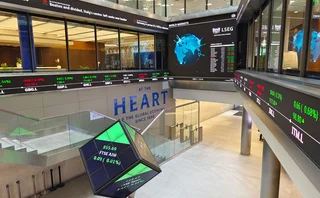
Credit derivatives house of the year: Citi
Risk Awards 2017: US bank racks up $500 billion in book deals, $9 billion in CDS basis trades

At the start of 2016, the outlook for credit markets was gloomy. Weak commodity prices, slowing global growth and the prospect of rising interest rates cast a pall over the market.
As energy bonds took a beating, and credit spreads widened across the board, some questioned whether balance-sheet-constrained dealers would be able to maintain an orderly market if investors bolted for the exits.
By the end of the year, the mood could not have been more different. "The extreme volatility at the beginning of the year wasn't good for anyone," says Brian Archer, head of global credit trading at Citi in New York. "But it actually wound up being a very good year for our clients. And as our clients do well, we tend to do well."
Rather than being overwhelmed by the volatility and macro events that defined the year, Citi's credit trading business thrived in 2016 – completing portfolio acquisitions worth more than $400 billion in total and executing $9 billion in credit default swap (CDS) basis packages for clients. Trading activity hit a peak in the aftermath of the UK's Brexit vote, then remained elevated up to the US presidential election in November, and all the way through to the end of the year.
For single names, indexes and bespoke tranches, Citi is far ahead of the rest of the market
A trader at another large credit hedge fund in New York
Buy-side firms also rate the bank highly. Asked where Citi ranks among the dealers he works with, one credit portfolio manager at a large New York-based hedge fund says simply "the best", adding: "We trade indexes, single names, options and tranches. Across all derivatives, I've found them to be the best provider of liquidity at the tightest bid-offer of anyone."
A trader at another large credit hedge fund in New York says: "For single names, indexes and bespoke tranches, Citi is far ahead of the rest of the market."
Citi ranks as the top global market-maker in CDS indexes on Bloomberg's swap execution facility, with a 15% market share. It also boasts a market share of roughly 15% in single-name CDS trading globally across the top investment-grade and high-yield names. And the firm is by far the largest liquidity provider in synthetic credit index tranches, with a market share of over 30%, according to US-based market intelligence provider Greenwich Associates.
Key centralised group
The roots of the bank's success lie in its decision in 2012 to set up a centralised group – led by Vikram Prasad, head of correlation and exotics trading – to handle capital, counterparty and portfolio risk optimisation across the credit derivatives business.
"We manage our capital very efficiently in the credit derivatives business," says Archer. "That meant we had the capital available to do the trades we've done over the past year."
He's referring in part to Citi's portfolio acquisitions – one of which is thought to have set a new record for the market.
In June, the firm agreed to acquire a $380 billion legacy portfolio of single-name CDSs from Credit Suisse – roughly 54,000 individual positions – allowing the Swiss bank to reduce its leverage exposure by $5 billion. The deal, which closed in August, was first reported by Bloomberg.
Prasad's group is responsible for unwinding and distributing the risk generated by such deals – which it does at a dizzying pace. "Over the last few years, we've significantly enhanced our capabilities as far as managing the counterparty risk these transactions generate," says Prasad.
Deep relationships
"We're extremely active in the interdealer markets, where we've built deep relationships that allow us to collapse notional and counterparty exposure in a very efficient and quick manner."
Coupled with a sophisticated technology infrastructure, which can process tens of thousands of line items at once, it allows the bank to digest huge amounts of derivatives risk in a short space of time – making Citi a popular bidder for dealers looking to dispose of legacy portfolios.
And as volatility rose and economic conditions worsened in Europe, there was no shortage of sellers. In all, Citi completed well over $400 billion in legacy single-name CDS portfolio acquisitions in 2016, while maintaining its overall leverage exposure within a tight band.

We're trying to find the most efficient ways to execute for clients
Vikram Prasad, Citi
Citi also found new ways to enable clients to move large amounts of credit risk – for instance, bundling bonds that clients want to sell into an exchange-traded fund (ETF) and offloading the risk in the equity market.
"We're trying to find the most efficient ways to execute for clients, and we've ramped up our use of ETFs to do that," says Prasad. "We can do a create to convert trades into an ETF and find a better clearing level for clients."
This simple idea has been very effective. Citi created over $1.6 billion worth of new shares in the iShares iBoxx USD Investment Grade Corporate Bond ETF (LQD) in the first 11 months of 2016 – accounting for around 40% of the fund's asset growth to that point in the year – including the single largest create ever in the ETF, at almost $900 million.
On the derivatives side, Citi has expanded Prasad's remit to encompass the bulk of its trading activity across structured credit tranches, CDS indexes, credit options and – most recently – investment-grade single-name CDSs.
Combining the structured credit, CDS index and single-name desks has greatly enhanced Citi's ability to intermediate client flows across these instruments. For instance, the firm has a number of clients that actively trade the CDS indexes against the underlying components. Previously, clients would have to call separate desks to execute each leg of the CDS basis trade.
"Now, when a client calls to trade the basis, they can get one number from one trader who's looking at it all day long," says Prasad. "We've made it a lot more efficient for clients to execute those basis trades."
Risk management
The new structure has also improved the firm's risk management. "As we're making markets in single names as well as indexes, there are times when it makes sense to collapse the risk by matching the single names to the index, and bundling that inventory into basis packages, which can be marketed to clients as a trading opportunity," says Prasad.
That allowed Citi to execute a whopping $9 billion of investment-grade CDS basis packages with clients in 2016.
"That change resulted in us doing a significant amount of notional in 2016 that we wouldn't have previously done," says Prasad.
The vast majority of the basis packages were cleared transactions, which receive more favourable treatment from a regulatory capital standpoint.
Folding single-name CDS trading into Prasad's team has also improved Citi's ability to offer liquidity to bank hedgers, such as credit valuation adjustment (CVA) desks.
"The structured credit client base is a natural seller of protection, whereas the banks are very active buyers of protection for a host of reasons. So, by combining CDS market-making with structured credit, we're able to link up our clients on the short side of the market with clients on the long side, so they can get more and better execution," says Prasad.
Ultimately, the decision to combine single-name trading with indexes and structured credit paid off in spades.
"It helped us to significantly increase our trading – especially with basis trades – and our ability to risk-manage single-name trades," says Prasad. "We've seen a meaningful pick-up in volume in both those products."
Citi's credit derivatives trading business also benefited from the launch of a series of new products in 2016, including total return swaps (TRSs) on the iBoxx high-yield index.
"We have a large group of clients that trade credit derivatives from a pure macro perspective, so we really focused on expanding our suite of macro product offerings," says Prasad.
Previously, these clients traded high-yield CDS indexes or ETFs with Citi. He adds: "To complete that product offering for clients, we now offer TRSs on iBoxx. That allows clients to trade relative value across a broader product spectrum, which makes for an interesting way to expand the macro product offering."
The bank also sought to improve transparency and liquidity in synthetic credit over the past year.
In 2014, Citi issued the first synthetic collateralised debt obligation (CDO) transaction since 2008 – reopening a market that had been dormant since the financial crisis. It continues to lead the market in so-called full capital structure bespoke CDOs – where every part of the capital structure is sold to investors – with notional volumes topping $7 billion in 2016.
Bravo portfolio
The challenge for clients lies in pricing these investments on a day-to-day basis. To address that problem, Citi began making two-way markets on a standardised portfolio of credits, called Bravo.
"The Bravo portfolio is very representative of the portfolios most of our clients find interesting, and we send out two-way markets on that portfolio, across every part of the capital structure, on a daily basis," says Prasad. "This way, clients can see what the capital structure looks like for synthetic structured credit at any given point in time."
Citi also made its structured credit-pricing engine available on its client portal, Velocity.
"Any of our clients can price tranche trades on our platform and get the same valuation as Citi's books and records," says Prasad.
"We're increasing transparency in what has historically been an opaque market, and reducing the barriers to entry. Clients don't need to call a dealer to price a tranche – they can go to Velocity, choose any part of the capital structure, and see exactly where Citi would price the trade."
Only users who have a paid subscription or are part of a corporate subscription are able to print or copy content.
To access these options, along with all other subscription benefits, please contact info@risk.net or view our subscription options here: http://subscriptions.risk.net/subscribe
You are currently unable to print this content. Please contact info@risk.net to find out more.
You are currently unable to copy this content. Please contact info@risk.net to find out more.
Copyright Infopro Digital Limited. All rights reserved.
As outlined in our terms and conditions, https://www.infopro-digital.com/terms-and-conditions/subscriptions/ (point 2.4), printing is limited to a single copy.
If you would like to purchase additional rights please email info@risk.net
Copyright Infopro Digital Limited. All rights reserved.
You may share this content using our article tools. As outlined in our terms and conditions, https://www.infopro-digital.com/terms-and-conditions/subscriptions/ (clause 2.4), an Authorised User may only make one copy of the materials for their own personal use. You must also comply with the restrictions in clause 2.5.
If you would like to purchase additional rights please email info@risk.net
More on Awards
Clearing house of the year: LCH
Risk Awards 2025: LCH outshines rivals in its commitment to innovation and co-operation with clearing members
Best use of machine learning/AI: CompatibL
CompatibL’s groundbreaking use of LLMs for automated trade entry earned the Best use of machine learning/AI award at the 2025 Risk Markets Technology Awards, redefining speed and reliability in what-if analytics
Markets Technology Awards 2025 winners’ review
Vendors jockeying for position in this year’s MTAs, as banks and regulators take aim at counterparty blind spots
Equity derivatives house of the year: Bank of America
Risk Awards 2025: Bank gains plaudits – and profits – with enhanced product range, including new variants of short-vol structures and equity dispersion
Law firm of the year: Linklaters
Risk Awards 2025: Law firm’s work helped buttress markets for credit derivatives, clearing and digital assets
Derivatives house of the year: UBS
Risk Awards 2025: Mega-merger expected to add $1 billion to markets revenues, via 30 integration projects
Interest rate derivatives house of the year: JP Morgan
Risk Awards 2025: Steepener hedges and Spire novations helped clients navigate shifting rates regime
Currency derivatives house of the year: UBS
Risk Awards 2025: Access to wealth management client base helped Swiss bank to recycle volatility and provide accurate pricing for a range of FX structures







